

What has changed at the world's largest professional social media platform during the pandemic, and how will it shift for B2B marketers in the post-pandemic landscape? LinkedIn* has already rolled out an impressive assortment of new features in 2021, and we’ve got 10 insights that B2B marketers need to know about them. Over the course of the pandemic, LinkedIn ads have been among the marketing channels that have grown the most in importance according to
report data examining B2B technology marketing strategies, as we covered in a
recent edition of the TopRank Marketing news. LinkedIn also saw a
revenue increase of 23 percent during the second quarter of fiscal year 2021, according to earnings release information from parent company Microsoft, led in part by strong advertising performance. What has lead to this growth? Let's jump right in an look at 10 new LinkedIn insights for B2B marketers.
1 — An Inspiring Array Of New Features For Company Pages
LinkedIn has added an inspiring array of new features for company pages on the platform, including several aimed at helping businesses involve their employees in finding and sharing its various types of content. A new “
My Community” tab added to company pages allows businesses to make sharing content from the company or other curated sources simpler, while also providing reach and engagement data to measure the effectiveness of employee advocacy. Company page administrators have been given new tools for recommending content to employees, along with a unique feature that suggests ways employees can turn what they share into distinctive content.
Employees are 14 times as likely to share their own organization’s page content compared to other brands, according to research from LinkedIn that also shows
co-workers are some 60 percent more likely to engage with posts from their teammates. The LinkedIn company page additions,
announced in February, work to strengthen a brand’s community on the platform, with other new features including an expansion of LinkedIn Stories that lets brands utilize destination links for swipe-up interactions. Other new additions have included increased lead generation functionality within LinkedIn’s product pages. By making it easy for company employees to share brand content, LinkedIn has made strides in
overcoming the notion that nobody looks at company pages — a place where content goes to die. Each new feature rolled out by LinkedIn offers B2B marketers new opportunities for connection and engagement. If you’ve missed other new LinkedIn additions and are looking for helpful ways to increase engagement by using them, our content marketing manager
Nick Nelson explores a variety of options in a helpful article on
boosting B2B marketing engagement on LinkedIn. [bctt tweet="“If your company’s approach to LinkedIn has been an autopilot, the time is right to buckle down and take advantage of the many opportunities afforded to B2B marketers by the world’s largest professional social network.” @NickNelsonMN" username="toprank"]
2 — LinkedIn Live Bolsters Brand Video Engagement
The importance of video has skyrocketed during the pandemic, and LinkedIn has accordingly seen sizable increases in utilization of its LinkedIn Live functionality. Usage statistics show that the professional social network’s
LinkedIn Live video streams have increased by 89 percent since March, 2020, along with strong levels of member engagement. While use of audio social platform Clubhouse has risen, the majority of B2B brands have so far taken a wait-and-see approach. Our
informal poll data showed that 52 percent of B2B marketers view Clubhouse as not important in their 2021 marketing strategy, with 28 percent having said that the jury was still out on its importance in their marketing efforts.
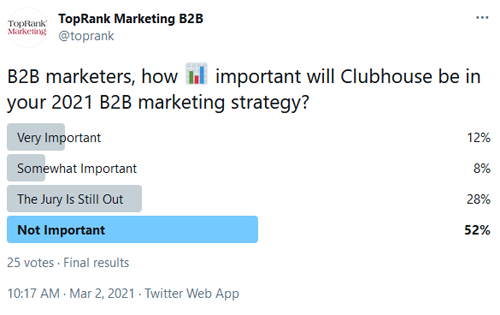
What do B2B brands need to ask themselves before utilizing Clubhouse and other trending new platforms? Our CEO and co-founder
Lee Odden offers up a sound strategy and shows how partnering with influencers can be key now more than ever in his recent “
How B2B Brands Can Boost Confidence in Livestream Video, Podcast and Clubhouse Marketing.” While most B2B marketers wait for Clubhouse’s impact on business marketing to play out, LinkedIn Live has seen steadily growing implementation among major brands. LinkedIn Live is being used by more major firms all the time, such as the 5 B2B brands I wrote about that are rocking their LinkedIn Live game, in “
Livestream Marketing: 5 B2B Brands Rocking LinkedIn Live,” featuring JPMorgan Chase, CompTIA, Microsoft, NASA, and SAP*. As more brands have embraced LinkedIn Live, marketers have shared information on how to utilize its numerous features, such as “
How to schedule livestreams to Facebook, YouTube, Twitter and LinkedIn.” [bctt tweet="“Content Marketers can boost the success of their marketing investment when they optimize content for discovery wherever buyers are looking, subscribing and influenced.” — Lee Odden @LeeOdden" username="toprank"]
3 — Planning For “The Big Long’’ Requires Patience
LinkedIn has taken a long-term look at B2B marketing trends, in the form of a robust collection of some 30 marketing trends it has researched over the past five years, available in report form in “
2030 B2B Trends: Contrarian Ideas For The Next Decade.” Putting all this data into perspective for use today can be a daunting challenge. Thankfully, however,
Ty Heath, director of market engagement at The B2B Institute at LinkedIn recently took the time to share her wealth of knowledge on the report and its most important trends, which I covered in “
LinkedIn’s Ty Heath: 3 Enduring B2B Marketing Trends #MPB2B.” Ty shared the importance of B2B marketers being able to strike just the right balance of short-term activation versus long term branding, and pointed out that one of brand-building’s truest strengths is its effect on long term sales. Recently LinkedIn’s
Peter Weinberg and
Jon Lombardo shared their views on the 2030 marketing trends report, looking at why brand investment is key for providing business value, in Marketing Week’s “
Why B2B marketers need to bet big on ‘The Big Long’.” “Brand building requires patience,” Weinberg and Lombardo noted. “Brands are built over decades, not quarters, by constantly investing in repeatable and distinctive creative concepts,” they added. Another resource LinkedIn has made available for B2B marketers is “
5 Principles Of Growth In B2B Marketing,” which examines the art of balancing the long-term brand-building goals with short-term sales activation concerns. [bctt tweet="“We can look forward to more memorable B2B marketing messages that connect brand to demand. If you are a creative B2B marketer, that's something you can get excited about.” — Ty Heath @tyrona" username="toprank"]
4 — Influence’s Increasing Strengths Well-Showcased Via LinkedIn
The success of LinkedIn Live has come in part due to its ability to drive brand awareness, and a growing number of recent studies have shown that industry subject matter experts and influencers have embraced live-streaming more than ever during the pandemic. Live-stream content produced by influencers has seen sustained interest during the global health crisis, according to
survey data, and B2B influencers in particular have found increased engagement through LinkedIn. Digging in to some of the details of this type of engagement on LinkedIn, we’ve presented five helpful case study examples in, “
5 Case Studies on How to Optimize B2B Influencer Engagement on LinkedIn.” The natural kinship between influence in B2B marketing and the LinkedIn platform offers brand marketers a number of particularly powerful opportunities, and we recently took a look at them in an in-depth video interview with
Garnor Morantes, group marketing manager at LinkedIn, who sat down with Lee in the second episode of our
Inside B2B Influence Marketing show. “
Inside Influence 2: Garnor Morantes from LinkedIn on the Power of Always-On Influence” explores what always-on influencer marketing is and how LinkedIn has developed an influencer community using an always-on approach, along with numerous other insights. Garnor was also among the many major brand contributors to our groundbreaking
2020 State of B2B Influencer Marketing Research Report.
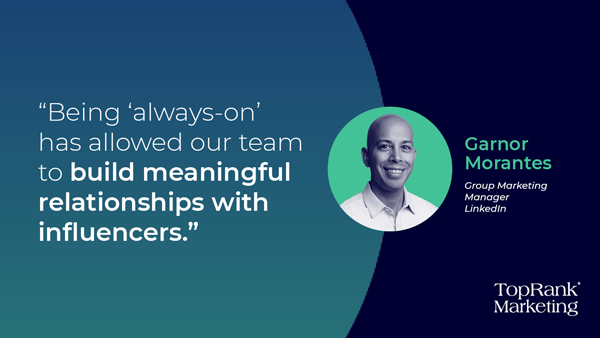
[bctt tweet="“Start thinking about who the audience truly is and as a result, who might be able to speak to them better than you can?” — Garnor Morantes of @LinkedIn" username="toprank"]
5 — Successfully Working With Changes To Apple’s Identifier for Advertising (IDFA) System
The digital marketing industry has had to take steps to adjust to major changes in how marketers implement ad tracking and targeting, as both Google and Apple have begun shifting away from traditional web browser cookie-tracking technology. LinkedIn announced in March’s “
Sharing an update on our plans for IDFA” that it would no longer collect Apple’s Identifier for Advertising (IDFA) data from its Apple iOS apps, in a change that — although affecting the LinkedIn Audience Network (LAN), conversion tracking and matched audiences features — is expected to have only limited campaign impact. Using first-party data instead, LinkedIn will offer similar functionality to help marketers reach relevant buyer audiences, a change savvy B2B marketers will want to keep tabs on as further information is released in the coming months. [bctt tweet="“The natural kinship between influence in B2B marketing and the LinkedIn platform offers brand marketers a number of particularly powerful opportunities.” — Lane R. Ellis @lanerellis" username="toprank"]
6 — Free Best-Practice Guides Help Point The Way For B2B Content Engagement
LinkedIn has also upped its best-practice and guide publication game during the pandemic, providing a wealth of information for digital marketers looking to achieve the highest levels of success using the platform. One of the newest offerings comes in the form of advertising campaign planning worksheets and templates, together in a 38-page guide, with the launch of “
A Template for Better LinkedIn Campaign Planning,” providing useful resources for a variety of traditional, carousel, video, and other LinkedIn ad types. LinkedIn has also released a 17-page guide offering B2B marketers tips, statistics and a variety of insight and examples surrounding the production of successful B2B creative assets on its platform, in the helpful “
[Pocket Guide] 3 Traits of Engaging B2B Creative.” Another recent resource for B2B marketers looking to grow engagement on LinkedIn is the platform’s “
Return to Grown 2021 Magazine,” featuring case studies, interviews, tips and more. Some of the guides LinkedIn has published are tailored to specific industries, such as “
Why consumer mindset matters in financial services marketing,” yet also offer universal insight of interest to all B2B marketers, including detailed study data showing that
LinkedIn members are more likely to have positive feelings after visiting the platform.
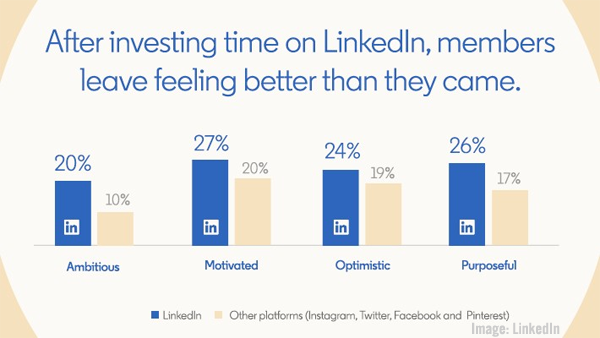
A final example of LinkedIn’s helpful guides is a recent examination of take-aways marketers can glean from the pandemic, in “
2020 was a creative experiment of two halves – here’s what we learned,” which looks at subjects including how brand distinctiveness drives creative thinking, and creativity’s longstanding bias against overt branding — among numerous other marketing-related topics.
7 — From Black History Month To A Year Of Change
During February’s Black History Month, LinkedIn highlighted an impressive array of initiatives aimed at focusing on and helping to removing barriers to success, including the release of an ongoing series called “
Conversations For Change.”
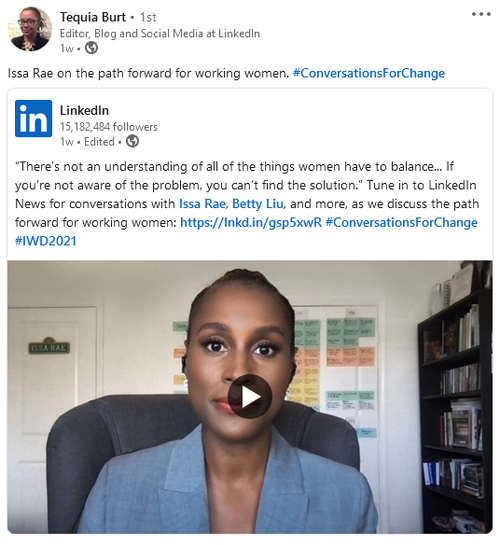
At TopRank Marketing we also published content centered around Black History Month, including a look at “
10 Marketing and Communications Leaders to Inspire You in 2021,” featuring a stellar group of women of color, including LinkedIn’s own Ty Heath and others.
8 — Moving Towards Facilitating Freelance Connections And More
Another area B2B marketers may want to keep tabs on is LinkedIn’s possible move towards offering features that would facilitate freelance connections — an area that has seen significant growth during the pandemic, and a feature that could prove helpful for certain LinkedIn users. In “
LinkedIn’s new Marketplaces will help freelancers find work,” Fortune’s
Andrew Marquardt looks into several ways such a LinkedIn feature might work, and the potential such a move would have in providing alternatives to similar functionality provided by existing third-party services Upwork and Fiverr. As the world's largest business-oriented social platform, such functionality could enhance LinkedIn in a new area, however marketers will need to wait and see how LinkedIn Marketplace is set to play out during the rest of 2021.
9 — Rising Poll Opportunities
LinkedIn launched the return of its highly-anticipated poll feature in 2020, offering marketers a new platform besides Twitter, Facebook, and Instagram for gathering community sentiment using polls — one that may be the most natural fit for many B2B brands. Polls offer a unique two-for-one value for B2B marketers, providing quality feedback on what customers want while also offering brands a helpful interactive social media content marketing element. Since the re-launch of polls on the platform, it has become more common to see polls among the content posted on LinkedIn. We examined some of the brands that took advantage of LinkedIn’s polling features, in “
Social Media Polls For Marketers: 6 B2B Brands Winning With LinkedIn Polls,” which shows examples of some of the ways that brands are innovating through the use of polls. [bctt tweet="“Poll data shows what marketers are thinking about when it comes to a variety of important subjects, ranging from everyday tasks to far-reaching future trends.” — Lane R. Ellis @lanerellis" username="toprank"]
10 — Eye-Raising Statistics Point To Useful LinkedIn Marketing Trends
Each of the nine areas we’ve looked at so far combine to tell a fascinating story about the rise of LinkedIn for B2B marketers during the pandemic — and point to continuing opportunities for post-pandemic marketing. Helping to highlight specific details about what’s happening with LinkedIn, here are just a few additional statistics that can help inform your own LinkedIn marketing strategy in 2021 and beyond.
- 45 percent of those who read articles on LinkedIn are high-level decision makers, and the social platform generates 80 percent of overall B2B social media leads (Source: SalesIntel / Hootsuite)
- Each week LinkedIn’s feeds get some 9 billion content impressions. (Source: Inc.)
- A user who follows a company on LinkedIn is 81 percent more likely to open an InMail from that brand than a non-follower. (Source: TechJury)
Bring New Focus to Your LinkedIn B2B Marketing
via GIPHY By incorporating the new LinkedIn features and insight we’ve examined here, you’ll have a sizable head start in bringing new focus to your own B2B marketing efforts on the platform. Creating trustworthy and award-winning B2B marketing takes significant effort, which leads many firms to choose working with a top digital marketing agency such as TopRank Marketing.
Contact us today and let us know how we can help, as we’ve done for businesses ranging from LinkedIn, Dell and 3M to Adobe, Oracle, monday.com and others.
*LinkedIn and SAP are TopRank Marketing clients.
The post 10 New Insights B2B Marketers Need To Know About LinkedIn In 2021 appeared first on B2B Marketing Blog - TopRank®.

Article Source:
http://bathseoexpert.blogspot.com/2021/03/10-new-insights-b2b-marketers-need-to.html
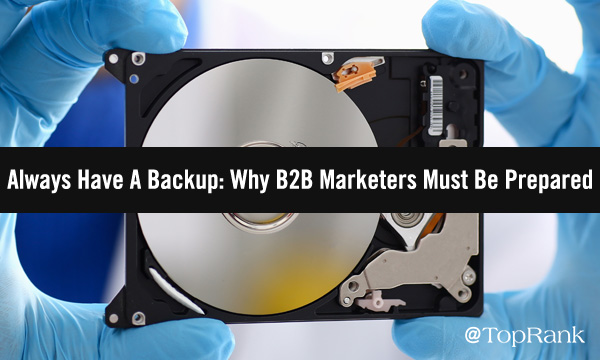
 Are you ready for World Backup Day? For World Backup Day we want to explore the importance of backing up not only your business’ data, but why B2B marketers should always have a backup plan B — and preferably also a plan C and D — at the ready. “Don’t be an April Fool. Be prepared. Back up your files on March 31st,” the World Backup Day website admonishes for the annual day celebrating the importance of backups, which falls just ahead of April Fool’s Day. I remember the first backup I made 37 years ago, when I decided that my heavily-modified BASIC code for the 300-baud computer bulletin board system (BBS) I operated needed to be safely duplicated, in case anything ever happened to the single copy in existence. On that day in 1984 I had to borrow a second Commodore 1541 5.25" floppy disk drive to backup my BBS program and the data my callers left in the form of public and private text messages — the precursor to modern email. I still vividly recall the sense of reassurance I felt having completed that first backup — my data safeguarded at least to the extent that I was able to achieve at the time. I still have those two floppies, and about a decade ago I successfully used a piece of hardware to hook up my old disk drive to my modern computer, while a utility copied the disks into a format that present day Commodore 64 emulator programs can read. Those old files then became a part of my regular backup scheme. Let’s take a look at both smart data backup strategies and why, as B2B marketers, we should always be prepared for the unexpected — and not just when it comes to potential data loss.
Are you ready for World Backup Day? For World Backup Day we want to explore the importance of backing up not only your business’ data, but why B2B marketers should always have a backup plan B — and preferably also a plan C and D — at the ready. “Don’t be an April Fool. Be prepared. Back up your files on March 31st,” the World Backup Day website admonishes for the annual day celebrating the importance of backups, which falls just ahead of April Fool’s Day. I remember the first backup I made 37 years ago, when I decided that my heavily-modified BASIC code for the 300-baud computer bulletin board system (BBS) I operated needed to be safely duplicated, in case anything ever happened to the single copy in existence. On that day in 1984 I had to borrow a second Commodore 1541 5.25" floppy disk drive to backup my BBS program and the data my callers left in the form of public and private text messages — the precursor to modern email. I still vividly recall the sense of reassurance I felt having completed that first backup — my data safeguarded at least to the extent that I was able to achieve at the time. I still have those two floppies, and about a decade ago I successfully used a piece of hardware to hook up my old disk drive to my modern computer, while a utility copied the disks into a format that present day Commodore 64 emulator programs can read. Those old files then became a part of my regular backup scheme. Let’s take a look at both smart data backup strategies and why, as B2B marketers, we should always be prepared for the unexpected — and not just when it comes to potential data loss.
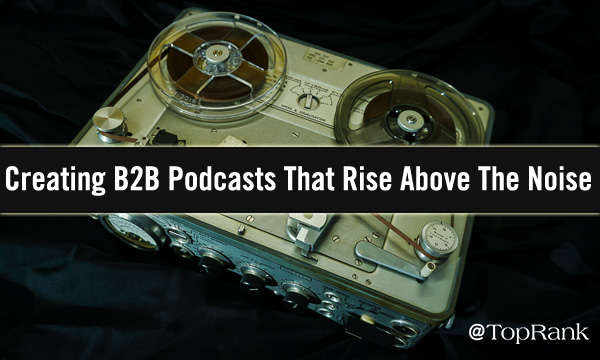
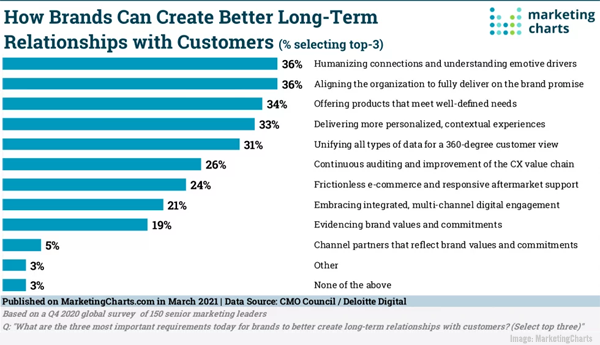
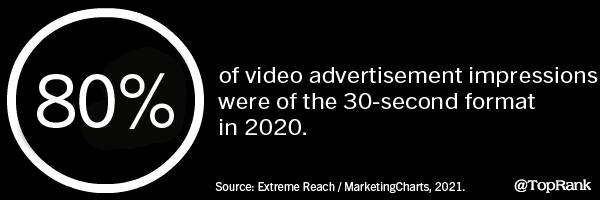 4As Report: Agencies Stepped Up In Times Of Trouble Client engagement levels at advertising agencies climbed some 90 percent over the past year as the pandemic spurred increased use of online collaboration tools — one of several findings of interest to digital marketers in newly-released American Association of Advertising Agencies study data.
4As Report: Agencies Stepped Up In Times Of Trouble Client engagement levels at advertising agencies climbed some 90 percent over the past year as the pandemic spurred increased use of online collaboration tools — one of several findings of interest to digital marketers in newly-released American Association of Advertising Agencies study data. 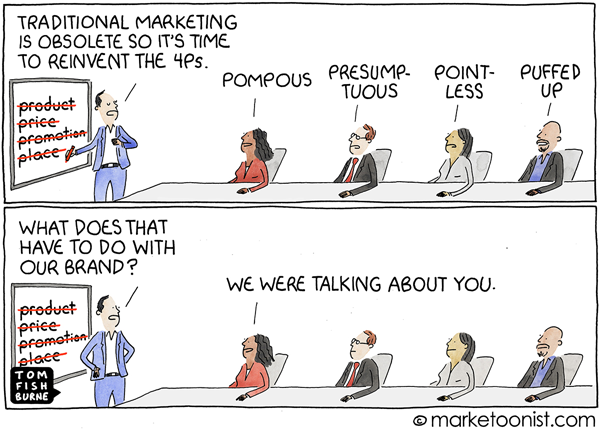 A lighthearted look at “reinventing the marketing 4Ps” by Marketoonist Tom Fishburne —
A lighthearted look at “reinventing the marketing 4Ps” by Marketoonist Tom Fishburne — 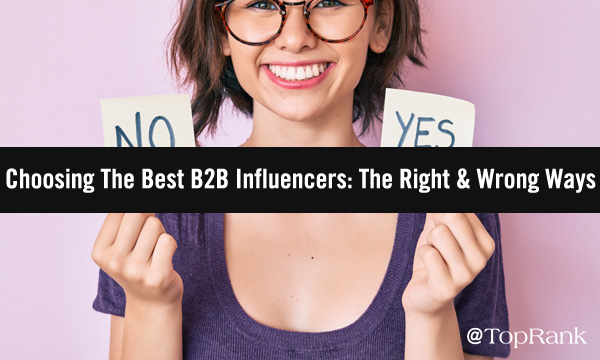
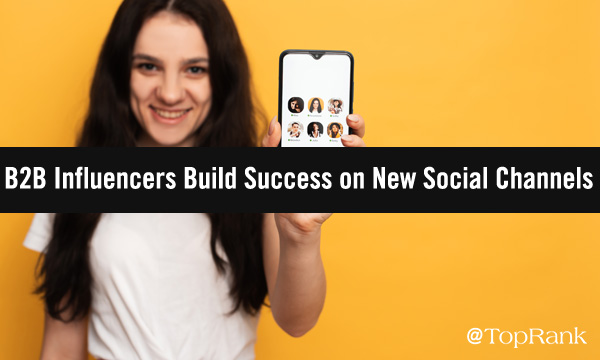


 The invite-only nature of Clubhouse can make it feel limiting, however.
The invite-only nature of Clubhouse can make it feel limiting, however.  Success can be measured in many ways, but adding to the bottom line is at the top of the list.
Success can be measured in many ways, but adding to the bottom line is at the top of the list.  If you follow the #TwitterSmarter weekly Twitter chat, you may have checked out the after party on Spaces with host and social media speaker and consultant
If you follow the #TwitterSmarter weekly Twitter chat, you may have checked out the after party on Spaces with host and social media speaker and consultant  “In terms of new platforms, there's no shortage of them; I'm even seeing some older platforms show up in my stream (such as Ello),” says
“In terms of new platforms, there's no shortage of them; I'm even seeing some older platforms show up in my stream (such as Ello),” says 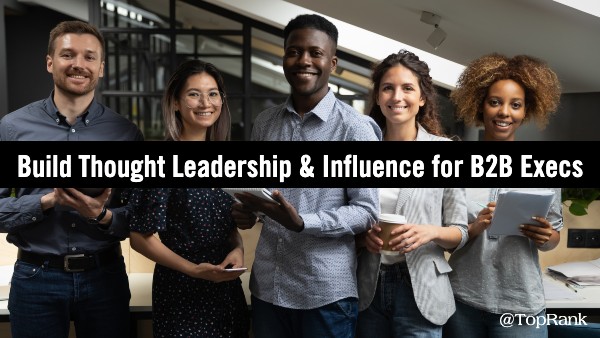
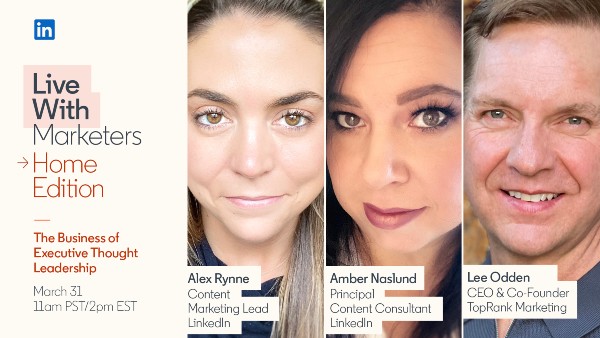
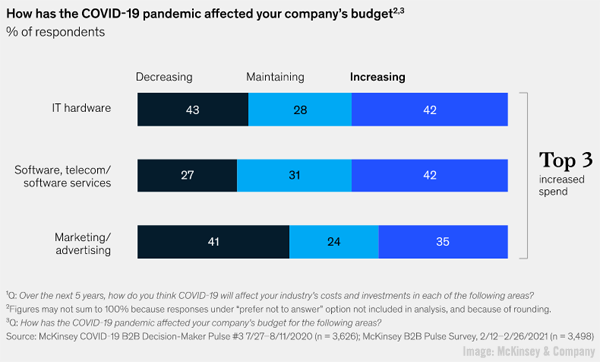
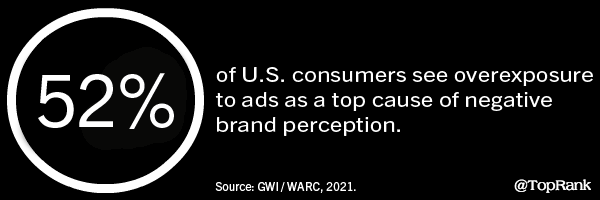 Hispanics Feel Brands Don't Understand Their Culture: Study 70 percent of U.S. Hispanics say that brands don’t understand the Hispanic culture, a figure that represents an increase from 59 percent in 2020, according to newly-released survey data.
Hispanics Feel Brands Don't Understand Their Culture: Study 70 percent of U.S. Hispanics say that brands don’t understand the Hispanic culture, a figure that represents an increase from 59 percent in 2020, according to newly-released survey data. 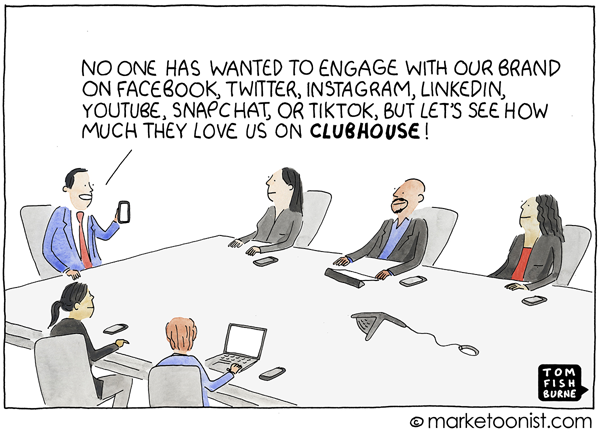 A lighthearted look at “brands on social media” by Marketoonist Tom Fishburne —
A lighthearted look at “brands on social media” by Marketoonist Tom Fishburne — 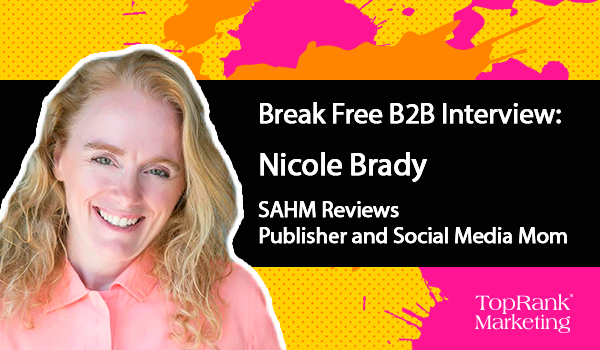

 What do B2B brands need to ask themselves before utilizing Clubhouse and other trending new platforms? Our CEO and co-founder
What do B2B brands need to ask themselves before utilizing Clubhouse and other trending new platforms? Our CEO and co-founder  [bctt tweet="“Start thinking about who the audience truly is and as a result, who might be able to speak to them better than you can?” — Garnor Morantes of @LinkedIn" username="toprank"]
[bctt tweet="“Start thinking about who the audience truly is and as a result, who might be able to speak to them better than you can?” — Garnor Morantes of @LinkedIn" username="toprank"]
 A final example of LinkedIn’s helpful guides is a recent examination of take-aways marketers can glean from the pandemic, in “
A final example of LinkedIn’s helpful guides is a recent examination of take-aways marketers can glean from the pandemic, in “ At TopRank Marketing we also published content centered around Black History Month, including a look at “
At TopRank Marketing we also published content centered around Black History Month, including a look at “